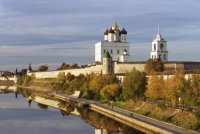Pskov
 Pskov, the centre of Pskovskaya oblast, is situated on the bank of the river Velikaya at its flowing into the river Pskova 689 kms to northwest from Moscow. The climate is moderately continental. Average temperatures of January are -8, of July +17 degrees centigrade. Precipitations are 600 mm a year. It is the railway unit (to Saint Petersburg, Vilnius, Bologoye, Riga) and the junction of highways. Here is also the airport in Pskov. The population is 208,5 thousand people (1992).
Pskov, the centre of Pskovskaya oblast, is situated on the bank of the river Velikaya at its flowing into the river Pskova 689 kms to northwest from Moscow. The climate is moderately continental. Average temperatures of January are -8, of July +17 degrees centigrade. Precipitations are 600 mm a year. It is the railway unit (to Saint Petersburg, Vilnius, Bologoye, Riga) and the junction of highways. Here is also the airport in Pskov. The population is 208,5 thousand people (1992).
Pskov first was mentioned in annals of the year 903 in connection with names of the princess Olga and the prince Igor. Pskov history is first of all the military history. The Pskov fortress is one of the largest ancient Russian fortresses that withstood 120 attacks and 26 large sieges. Since XVI Pskov became the capital of an independent state - the Pskov feudal republic. It was time of Pskov's fullest flower when it even minted its own coin.
In modern Pskov the leading industries is the machine-building. Plants of the city produce the electric equipment, radio components, communication equipment, the machinery for manufacture of artificial and synthetic fibres, etc. The light, sewing, tanning, food-processing industries and manufacture of building materials are also highly developed.
Educational institutions are the Pedagogical Institute and the branch of the St.-Petersburg Technical University.
Theatres: the Drama and Puppet theatre; Philharmonic society; the planetarium.
Museums: the Historical and Art and the Architectural Museums with branches "Izborsk fortress" in Izborsk, the Museum named after K.I.Nazarova in Ostrov town, the Museum named after M.P.Musorgsky in Kuninsky district, Manor of N.A. Rimsky-Korsakov in Plyussky district, the House of V.I.Lenin, the Museum of the artist and restorer Y.P.Spegalsky.
In the centre of the most ancient part of the city at the confluence of the rivers Velikaya and Pskova stands the Pskov Kremlin - Krom. District around Krom are divided into 4 parts: Dovmontov town, Middle town, Okolny town and Zapskoviye.
In Pskov and its suburbs were preserved and restored many noteworthy historical and architectural monuments. There are some works of Pskov iconographic school in the Pskov historical-architectural and art reserve. Frescos of XII century are carefully kept in the Spaso-Preobrazhensky Cathedral of the Mirozhsky monastery. These frescos are registered by UNESCO as the monuments of culture of world value.
Near Pskov lies the Izborsk fortress (XIV) connected with the legendary Varangian Truvor. The fortress affords a fine view on the Zheraviye lake and Izborsk valley, which is natural reserve.
At the border with Estonia stands the Svyato-Uspensky Monastery, which picturesque architectural ensemble has been formed for several centuries.
In the south of the Pskov land the Pushkin Reserve is situated. It is the territory that keeps ashes of the great Russian poet.
CITIES OF RUSSIA
Abakan I
Aginskoye I
Anadyr I
Arkhangelsk I
Astrakhan I
Barnaul I
Belgorod I
Birobidzhan I
Blagoveshensk I
Bryansk I
Cheboksary I
Chelyabinsk I
Cherkessk I
Chita I
Ekaterinburg I
Elista I
Gorno-Altaisk I
Groznyi I
Ioshkar-Ola I
Irkutsk I
Ivanovo I
Izhevsk I
Kaliningrad I
Kaluga I
Kazan I
Kemerovo I
Khabarovsk I
Khanty-Mansiysk I
Kirov I
Kostroma I
Krasnodar I
Krasnoyarsk I
Kudymkar I
Kurgan I
Kursk I
Kyzyl I
Lipetsk I
Magadan I
Maikop I
Makhachkala I
Moscow I
Murmansk I
Nalchik I
Naryan-Mar I
Nizhny Novgorod I
Norilsk I
Novgorod the Great I
Novosibirsk I
Omsk I
Orenburg I
Oryol I
Penza I
Perm I
Petropavlovsk-Kamchatsky I
Petrozavodsk I
Pskov I
Rostov the Great I
Ryazan I
Saint-Petersburg I
Salekhard I
Samara I
Saransk I
Saratov I
Smolensk I
Stavropol I
Syktyvkar I
Tambov I
Tomsk I
Tula I
Tver I
Tyumen I
Ufa I
Ulan-Ude I
Ulyanovsk I
Vladikavkaz I
Vladimir I
Vladivostok I
Volgograd I
Vologda I
Voronezh I
Yakutsk I
Yaroslavl I
Yuzhno-Sakhalinsk I
|